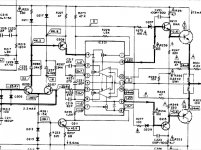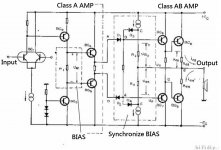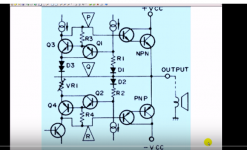I've recently acquired pioneer SA-770. Not much to look at but the first time I tried it I was impressed with the sound, reminds me of Class A which is what I like. The amp also runs quiet warm on idle like A class amps. The amp says it's non-switching circuit so I wonder if it is really Class A. Anyone knows what that means or is it just another marketing trick?
Hi, it is not a real Class A amp, it is a class AB amp.
They call it Class A means that the bias circuit is setting both output power transistors working in continues(no cut off/switching as normal class AB amp), the power transistors working in this condition is like some kind of class A circuit.
They call it Class A means that the bias circuit is setting both output power transistors working in continues(no cut off/switching as normal class AB amp), the power transistors working in this condition is like some kind of class A circuit.
The schematic is a bit over my head, I'm not good with transistors. I build tube amps but when it comes to NPN/PNP transistors, I'm lost so I stick to tubes.
So I guess if it doesn't have switching circuit (splitter?) than the output transistors work somewhat in parallel fashion being NPN and PnP and that makes it AB? That way it can produce 50W otherwise they'd have to use one really big transistor for A class to get that power which will probably be too inefficient and require lot of current...I'm guessing here.
So I guess if it doesn't have switching circuit (splitter?) than the output transistors work somewhat in parallel fashion being NPN and PnP and that makes it AB? That way it can produce 50W otherwise they'd have to use one really big transistor for A class to get that power which will probably be too inefficient and require lot of current...I'm guessing here.
Last edited:
I have to study too to wrap my head around this 'solution'. It's a lot of electronic dressing to prevent Q1/Q2 (Q213/Q215) from switching off. It's a double OTA with three inputs in different configuration, 'rubber' zeners and current mirrors. Really complex indeed.
This is a Technics New Class A simplify diagram, there is an extra synchronize BIAS circuit which always BIAS the output power transistors in any driving signal conditions, so that the output power transistors never switching off. Later other companies develop an IC New Class A version.
Attachments
The question is, how well do all of these actually work, and what's the price (e.g. power dissipation, shoot-through even)?
I remember an article about a sliding bias setup from the '70s that actually seemed to do what it was supposed to.
I remember an article about a sliding bias setup from the '70s that actually seemed to do what it was supposed to.
The New Class A circuit just compensate a BIAS current to the power transistor(to be switching off in the normal Class AB condition) to prevent it switching off, the BIAS current is just like the idling current to the power transistor, so that the New Class A amp total power dissipation is almost same as a normal Class AB amp.
I mod a Class AB amp using the Technics New Class A BIAS circuit many years ago.
I can't tell the difference after the mod.
A Class AB amp with sufficient BIAS current is already solved the crossover distortion problem, I think the New Class A circuit can not improve the sound very much, so that not much amp using this New Class A circuit nowadays.
I mod a Class AB amp using the Technics New Class A BIAS circuit many years ago.
I can't tell the difference after the mod.
A Class AB amp with sufficient BIAS current is already solved the crossover distortion problem, I think the New Class A circuit can not improve the sound very much, so that not much amp using this New Class A circuit nowadays.
I would suspect they don't use it nowadays too much because it's not efficient like other classes that can produce more output at over all at same current draw and not wasting energy while the amp is sitting at idle doing nothing but still runs hot. But I do like the sound of A class, personally I don't care about efficiency but it's not an amp I would use in a studio that's turned on 15 hours a day.
Just a very rough guess but by feeling the amp's temperature by hand while in idle I'd say it's something like a 50W heater, so not cheap to leave running non-stop.
On the other hand my 10W tube amp produces about the same amount of heat so way less efficient than the transistor, but better for my ears still.
Just a very rough guess but by feeling the amp's temperature by hand while in idle I'd say it's something like a 50W heater, so not cheap to leave running non-stop.
On the other hand my 10W tube amp produces about the same amount of heat so way less efficient than the transistor, but better for my ears still.
- Home
- Amplifiers
- Solid State
- pioneer sa-770 non-switching circuit


